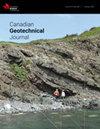多年冻土区灌浆杆锚的现场试验
IF 3.5
3区 工程技术
Q2 ENGINEERING, GEOLOGICAL
引用次数: 41
摘要
近年来,加拿大北部的电力传输和通信系统使用固定式塔受到越来越多的关注。在许多情况下,永久冻土会造成特殊的问题。在冻土上建造的锚杆结构的锚杆设计中,必须对冻土的抗上拔力进行评估。然而,关于冻土在上升力或各种类型锚杆的能力下的响应行为,很少有经验或信息可用。因此,加拿大国家研究委员会建筑研究部对永久冻土中的锚进行了实地研究,特别评估了与冻土在荷载作用下的长期蠕变有关的位移。对各种锚杆的初步评价表明,灌浆杆锚杆是一种值得研究的锚杆类型。1967年初,在马尼托巴省汤普森和吉拉姆的永久冻土带上总共安装了18个这样的锚(每个地点9个)。本文介绍了两个地点锚杆的安装和测试过程以及测试方案的结果。在结果分析中,考虑温度和正压的影响,注浆锚杆的蠕变行为与冻土的U基本蠕变参数有关。所采用的理论允许使用现场蠕变数据来估计冻土的长期冻结强度,这是设计中需要的信息本文章由计算机程序翻译,如有差异,请以英文原文为准。
Field Tests of Grouted Rod Anchors in Permafrost
The use of guyed towers for power transmission and communication systems in northern Canada has received increased attention in recent years. In many cases perennially frozen ground (permafrost) poses special problems. The resistance of frozen soil to uplift forces must be evaluated for the design of anchors of guyed structures built on permafrost. There is little experience or information available, however, concerning the behavior of frozen soil in response to uplift forces or the capacity of various types of anchors. A field study of anchors in permafrost was therefore undertaken by the Division of Building Research of the National Research counci l of Canada to evaluate, in particular, the displacements associated with long-term creep of frozen soil under load. initial appraisal of various kinds of anchors suggested that grouted rod anchors were a type that should be investigated. Early in 1967 a total of 18 such anchors (nine at each site) were installed in permafrost at Thompson and Gillam, Manitoba. This paper describes the installation and testing procedures and the results of the test programs conducted on the anchors at both sites. In the analysis of the results the creep behavior of grouted anchors is related to U basic creep parameters of frozen soil, taking into account the effects of temperature and normal pressure. The theory employed allows field creep data to be used for estimating the long-term adfreeze strength of frozen soil, information that is required in the design
求助全文
通过发布文献求助,成功后即可免费获取论文全文。
去求助
来源期刊

Canadian Geotechnical Journal
地学-地球科学综合
CiteScore
7.20
自引率
5.60%
发文量
163
审稿时长
7.5 months
期刊介绍:
The Canadian Geotechnical Journal features articles, notes, reviews, and discussions related to new developments in geotechnical and geoenvironmental engineering, and applied sciences. The topics of papers written by researchers and engineers/scientists active in industry include soil and rock mechanics, material properties and fundamental behaviour, site characterization, foundations, excavations, tunnels, dams and embankments, slopes, landslides, geological and rock engineering, ground improvement, hydrogeology and contaminant hydrogeology, geochemistry, waste management, geosynthetics, offshore engineering, ice, frozen ground and northern engineering, risk and reliability applications, and physical and numerical modelling.
Contributions that have practical relevance are preferred, including case records. Purely theoretical contributions are not generally published unless they are on a topic of special interest (like unsaturated soil mechanics or cold regions geotechnics) or they have direct practical value.
 求助内容:
求助内容: 应助结果提醒方式:
应助结果提醒方式:


